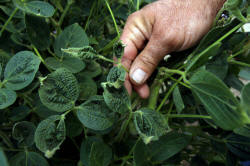|
Exclusive: EPA eyes
limits for agricultural chemical linked to crop damage
 Send a link to a friend
Send a link to a friend
 [September 05, 2017]
By Tom Polansek and Emily Flitter [September 05, 2017]
By Tom Polansek and Emily Flitter
(Reuters) - The U.S. environmental agency
is considering banning sprayings of the agricultural herbicide dicamba
after a set deadline next year, according to state officials advising
the agency on its response to crop damage linked to the weed killer.
Setting a cut-off date, possibly sometime in the first half of 2018,
would aim to protect plants vulnerable to dicamba, after growers across
the U.S. farm belt reported the chemical drifted from where it was
sprayed this summer, damaging millions of acres of soybeans and other
crops.
A ban could hurt sales by Monsanto Co <MON.N> and DuPont which sell
dicamba weed killers and soybean seeds with Monsanto's dicamba-tolerant
Xtend trait. BASF <BASFn.DE> also sells a dicamba herbicide.
It is not yet known how damage attributed to the herbicides, used on
Xtend soybeans and cotton, will affect yields of soybeans unable to
withstand dicamba because the crops have not been harvested.

The Environmental Protection Agency (EPA) discussed a deadline for next
year's sprayings on a call with state officials last month that
addressed steps the agency could take to prevent a repeat of the damage,
four participants on the call told Reuters.
It was the latest of at least three conference calls the EPA has held
with state regulators and experts since late July dedicated to dicamba-related
crop damage and the first to focus on how to respond to the problem,
participants said.
A cut-off date for usage in spring or early summer could protect
vulnerable plants by only allowing farmers to spray fields before
soybeans emerge from the ground, according to weed and pesticide
specialists.
Monsanto spokeswoman Christi Dixon told Reuters on Aug. 23, the day of
the last EPA call, that the agency had not indicated it planned to
prohibit sprayings of dicamba herbicides on soybeans that had emerged.
That action "would not be warranted," she said.
The EPA had no immediate comment.
EPA officials on the last call made clear that it would be unacceptable
to see the same extent of crop damage again next year, according to
Andrew Thostenson, a pesticide specialist for North Dakota State
University who participated in the call.
They said "there needed to be some significant changes for the use rules
if we're going to maintain it in 2018," he said about dicamba usage.
State regulators and university specialists from Arkansas, Missouri,
Illinois, Iowa and North Dakota are pressuring the EPA to decide soon on
rules guiding usage because farmers will make planting decisions for
next spring over the next several months.

Tighter usage limits could discourage cash-strapped growers from buying
Monsanto's more expensive dicamba-resistant Xtend soybean seeds. Dicamba-tolerant
soybeans cost about $64 a bag, compared with about $28 a bag for
Monsanto's Roundup Ready soybeans and about $50 a bag for soybeans
resistant to Bayer's Liberty herbicide.
Already, a task force in Arkansas has advised the state to bar dicamba
sprayings after April 15 next year, which would prevent most farmers
there from using dicamba on Xtend soybeans after they emerge.
Arkansas previously blocked sales of Monsanto's dicamba herbicide,
XtendiMax with VaporGrip, in the state.
[to top of second column] |

John Weiss looks over
his crop of soybeans, which he had reported to the state board for
showing signs of damage due to the drifting of Monsanto's pesticide
Dicamba, at his farm in Dell, Arkansas, U.S. July 25, 2017.
REUTERS/Karen Pulfer Focht/File Photo

"If the EPA imposed a April 15 cut-off date for dicamba spraying, that would be
catastrophic for Xtend - it invalidates the entire point of planting it," said
Jonas Oxgaard, analyst for investment management firm Bernstein.
Monsanto has projected its Xtend crop system would return a $5 to $10 premium
per acre over soybeans with glyphosate resistance alone, creating a $400-$800
million opportunity for the company once the seeds are planted on an expected 80
million acres in the United States, according to Oxgaard.
By 2019, Monsanto predicts U.S. farmers will plant Xtend soybeans on 55 million
acres, or more than 60 percent of the total planted this year.
RISKY DRIFT
About 3.1 million acres of soybeans vulnerable to dicamba were hurt by sprayings
this summer, accounting for 3.5 percent of U.S. plantings, according to the
University of Missouri. (Graphic: http://tmsnrt.rs/2feVSxz)
Chemical companies have blamed the crop damage on farmers misusing the
herbicides.
Specialists, though, say the weed killers are also risky because they have a
tendency to vaporize and drift across fields, referred to as volatility. Summer
can be a riskier time for sprayings, they said, because high temperatures can
increase volatility.

Monsanto previously denied requests by university researchers to study its
XtendiMax herbicide for volatility, as previously reported by Reuters. In the
end, the EPA gave dicamba weed killers from Monsanto and BASF abridged two-year
registrations, less than the five years experts say is more common.
To address the crop damage, the EPA has also asked state officials about
enhanced training for dicamba users; tighter restrictions on when and how the
herbicides can be sprayed; and the possibility of reclassifying the products so
the general public could not buy them, according to participants on the call.
"Everything is an option," said Jason Norsworthy, a University of Arkansas
professor who was on the call.
Monsanto Chief Technology Officer Robb Fraley said in a statement that the
company was communicating with the EPA, which is "evaluating potential actions
to facilitate enhanced training and compliance for 2018."
DuPont, too, is working with the EPA and state regulators on issues involving
its dicamba herbicide, FeXapan, spokeswoman Laura Svec said.
Rival BASF "could see some label enhancements" to its dicamba herbicide, Engenia,
if the EPA requires changes, spokeswoman Odessa Hines told Reuters. The company
"will be as flexible as possible" so farmers can use the product, she said.
(This version of the story corrects "are" to "is" in the first paragraph)
(Reporting by Tom Polansek in Chicago and Emily Flitter in New York. Additional
reporting by Karl Plume in Chicago and Rod Nickel in Winnipeg)
[© 2017 Thomson Reuters. All rights
reserved.] Copyright 2017 Reuters. All rights reserved. This material may not be published,
broadcast, rewritten or redistributed.
 |